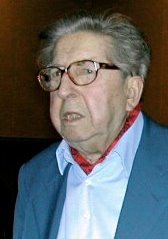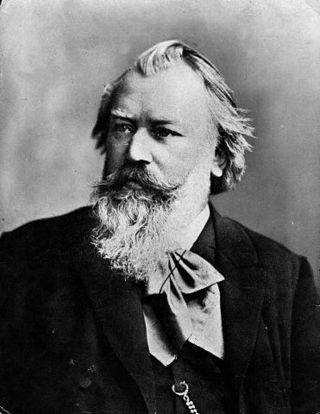
Mstislav Leopoldovich Rostropovich was a Russian cellist and conductor. In addition to his interpretations and technique, he was well known for both inspiring and commissioning new works, which enlarged the cello repertoire more than any cellist before or since. He inspired and premiered over 100 pieces, forming long-standing friendships and artistic partnerships with composers including Dmitri Shostakovich, Sergei Prokofiev, Henri Dutilleux, Witold Lutosławski, Olivier Messiaen, Luciano Berio, Krzysztof Penderecki, Alfred Schnittke, Norbert Moret, Andreas Makris, Leonard Bernstein, Aram Khachaturian, and Benjamin Britten.
The Cello Concerto No. 1 in E-flat major, Op. 107, was composed in 1959 by Dmitri Shostakovich. Shostakovich wrote the work for his friend Mstislav Rostropovich, who committed it to memory in four days. He premiered it on October 4, 1959, at the Large Hall of the Leningrad Conservatory with the Leningrad Philharmonic Orchestra conducted by Yevgeny Mravinsky. The first recording was made in two days following the premiere by Rostropovich and the Moscow Philharmonic Orchestra conducted by Aleksandr Gauk.
Dmitri Shostakovich wrote his Cello Concerto No. 2, Op. 126, in 1966 in the Crimea. Like the first concerto, it was written for Mstislav Rostropovich, who gave the premiere in Moscow under Yevgeny Svetlanov on 25 September 1966 at the composer's 60th birthday concert. The concerto is sometimes listed as in the key of G, but the score gives no such indication.
The Cello Concerto in A minor, Op. 129, by Robert Schumann was completed in a period of only two weeks, between 10 October and 24 October 1850, shortly after Schumann became the music director at Düsseldorf.

Henri Paul Julien Dutilleux was a French composer of late 20th-century classical music. Among the leading French composers of his time, his work was rooted in the Impressionistic style of Debussy and Ravel, but in an idiosyncratic, individual style. Among his best known works are his early Flute Sonatine and Piano Sonata; concertos for cello, Tout un monde lointain... and violin, L'arbre des songes ; a string quartet known as Ainsi la nuit ; and two symphonies: No. 1 (1951) and No. 2 Le Double (1959).

Rodion Konstantinovich Shchedrin is a Soviet and Russian composer and pianist, winner of USSR State Prize (1972), the Lenin Prize (1984), and the State Prize of the Russian Federation (1992), and is a former member of the Inter-regional Deputies Group (1989–1991). He is also a citizen of Lithuania and Spain.

The Double Concerto in A minor, Op. 102, by Johannes Brahms is a concerto for violin, cello and orchestra. The orchestra consists of 2 flutes, 2 oboes, 2 clarinets, 2 bassoons, 4 horns, 2 trumpets, timpani and strings.

Truls Olaf Otterbech Mørk is a Norwegian cellist.

Harold en Italie, symphonie avec un alto principal, as the manuscript describes it, is a four-movement orchestral work by Hector Berlioz, his Opus 16, H. 68, written in 1834. Throughout, the unusual viola part represents the titular protagonist, without casting the form as a concerto. The movements have these titles, alluding to a programme:
- Harold in the mountains
- March of the pilgrims
- Serenade of an Abruzzo mountaineer
- Orgy of bandits

David Geringas is a Lithuanian cellist and conductor who studied under Mstislav Rostropovich. In 1970 he won the gold medal at the International Tchaikovsky Competition. He also plays the baryton, a rare instrument associated with music of Joseph Haydn.
Camille Saint-Saëns composed his Cello Concerto No. 1 in A minor, Op. 33, in 1872, when he was 37 years old. He wrote this work for the French cellist, viola da gamba player and instrument maker Auguste Tolbecque. Tolbecque was part of a distinguished family of musicians closely associated with the Société des Concerts du Conservatoire, France's leading concert society. The concerto was first performed on January 19, 1873, at the Paris Conservatoire concert with Tolbecque as soloist. This was considered a mark of Saint-Saëns' growing acceptance by the French musical establishment.

The Festival d'Aix-en-Provence is an annual international music festival which takes place each summer in Aix-en-Provence, principally in July. Devoted mainly to opera, it also includes concerts of orchestral, chamber, vocal and solo instrumental music.
Émile Naoumoff is a Bulgarian pianist and composer. He revealed himself a musical prodigy at age five, taking up study of the piano and adding composition to his studies a year later. At the age of eight, after a fateful meeting in Paris, he became the last disciple of Nadia Boulanger, who referred to him as "the gift of my old age". He studied with her until her death in late 1979. Boulanger gave him the opportunity to work with Clifford Curzon, Igor Markevitch, Robert and Gaby Casadesus, Nikita Magaloff, Jean Françaix, Leonard Bernstein, Soulima Stravinsky, Aram Khachaturian, Sviatoslav Richter and Yehudi Menuhin. Lord Menuhin conducted the premiere of Naoumoff's first Piano Concerto, with the composer as soloist when he was ten years old. He pursued studies at the Paris Conservatory with Lélia Gousseau, Pierre Sancan, Geneviève Joy-Dutilleux, as well as at the Ecole Normale de Musique de Paris with Pierre Dervaux (conducting).
L'arbre des songes is a violin concerto written by Henri Dutilleux between 1983 and 1985. It is dedicated to Isaac Stern.
Henri Demarquette is a French contemporary classical cellist.
Xavier Phillips is a French contemporary classical cellist, the brother of violinist Jean-Marc Phillips-Varjabédian.
Étienne Péclard is a contemporary French cellist.
Pascal Rophé is a French conductor. He is currently music director of the Orchestre national des Pays de la Loire.

Sonia Wieder-Atherton is a Franco-American classical cellist.









